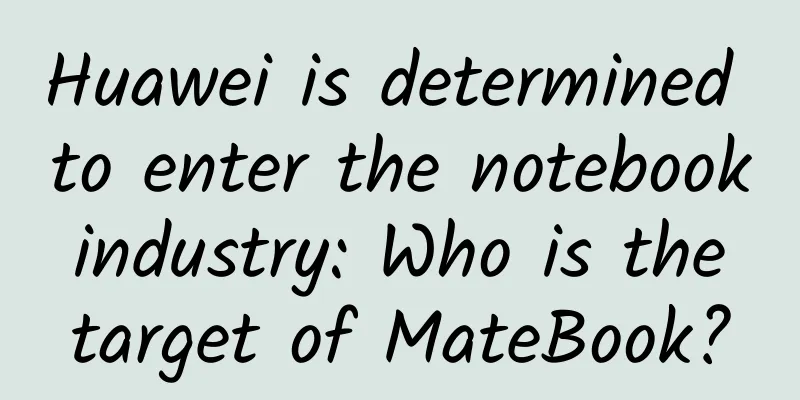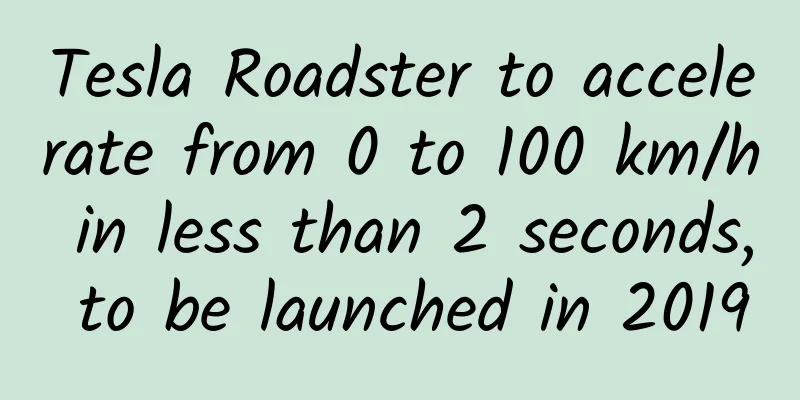Huawei is determined to enter the notebook industry: Who is the target of MateBook?

|
The Barcelona Mobile World Congress (2016 MWC) will be held in one day. A warm-up poster with the message "Lighter than light, thinner than thin, faster than fast. Apart from these gimmicks, what else can PC do?" appeared on Weibo today, indicating that Huawei's MateBook notebook will be officially released tonight. Rumors of Huawei entering the notebook product market began in 2012. Yu Chengdong, CEO of Huawei's consumer business, who is known as "Brother Mouth", said on Weibo at the time: "In the future, we will strive to gradually convert every Huawei employee's laptop to Huawei's quad-core processor MediaPad 10 FHD, running Windows 8. When plugged into the keyboard and mouse dock, it becomes an ultra-thin laptop, and when unplugged, it becomes a 1920 x 1200 full HD Pad. It also supports LTE wireless high-speed Internet access of up to 150Mbits, making mobile office more efficient. We are pushing Microsoft's Windows 8 to support full HD ultra-high resolution as soon as possible."
On September 21 last year, Huawei applied for a trademark named "MateBook", which aroused the attention of the industry and users to Huawei's entry into the notebook computer market. Combined with Yu Chengdong's comment to reporters at the 2015 Huawei semi-annual performance conference that "most people use Apple computers, and Huawei hopes that future products can satisfy more consumers", it aroused the attention of the industry and users to Huawei's entry into the notebook computer market. Huawei shipped more than 100 million smartphones in 2016, becoming the world's third largest smartphone company. It has also deployed an offensive strategy to "compete with Samsung" in the global market. So what are the timing and reasons for entering the notebook market at this time? Yiguancha conducted an in-depth discussion with relevant industry chain personnel, and the analysis is as follows: The traditional notebook industry has reached a period of innovation again After more than ten years of full market competition, the traditional notebook computer market has been saturated for many years, which is mainly reflected in the following three aspects: 1. Market capacity has declined significantly. According to data released recently by consulting firm TrendForce, global notebook shipments in 2015 totaled 164.4 million units, down 6.3% from 2014 (175.5 million units), and are expected to drop further to 159.2 million units in 2016 (down about 9.3%). 2. The market share of major companies is highly concentrated and relatively stable. According to TrendForce data, the top six notebook computer companies accounted for 83.4% of the market share in 2015, namely HP (20.5%), Lenovo (19.9%), Dell (13.7%), Apple (10.34%), Asus (10.31%), and Acer (8.9%). Compared with the same period in 2014 or compared with the expectations for 2016, except for Apple, the market share of each company has not changed significantly. In the Chinese market, Lenovo has maintained its dominance for many years. According to Tong Fuyao, vice president of Lenovo Group and president of China, Lenovo's goal for the 2015 fiscal year is to achieve a 40% domestic overall PC market share. 3. Slow progress in hardware product innovation. The industry is highly monopolized by several major companies, which will inevitably lead to a decline in overall competitiveness. This is reflected in the fact that the product form of laptops has not changed fundamentally in the past decade. Although Intel has been pushing traditional laptops to transform into lightweight, long standby, and cheap products under the weakening of the Moore's Effect, the decline in user demand for replacement and the fact that various PC companies have made ultrabooks a minority of high-end products in order to preserve their original product systems and profits have created an innovation dilemma in the notebook industry today. From the above three perspectives, the notebook industry has reached the reconstruction period of the "post-red ocean market", and innovation must come from the "disruptive innovation" of new entrants to break the solidified industry monopoly and product innovation dilemma. Interestingly, a senior practitioner who has worked in a well-known domestic PC for nearly 10 years also told "Yi Guancha" that the division of interests and product rigidity formed within PC companies over the years also hope that new competitors such as Huawei will enter, forcing PC companies and the industry to accelerate transformation. Xu Qinsong, vice president of Huawei's consumer business, said: "It is a development trend for smartphone manufacturers to get involved in the PC industry. The advantages of a complete corporate ecosystem are the basis for our ability to carry out all-round innovation." PC is a money-making industry Compared with the fierce price war in the domestic mobile phone market, where even companies are willing to disclose their own and competitors' hardware BOM prices, the PC industry seems to be in a period of solidification and stability after eliminating many competitors, and most of the major players are making money. Take Lenovo as an example. Although its mobile phone business is losing money, its PC business is making money. For example, in the second quarter of 2015, Lenovo's mobile business lost $217 million, but its PC business made a pre-tax profit of $406 million, with a pre-tax profit margin of 5%. In other words, Lenovo is using its PC business to provide blood transfusions to its mobile business, and its 5% pre-tax profit margin is far higher than that of most domestic mobile phone companies. From this perspective, compared to the smartphone industry, the PC notebook industry is an industry that has seen its profit margins recover and improve after years of reshuffles, which is inconsistent with most people's traditional perceptions. Huawei chose to enter an industry with far less intense competition than the smartphone industry at this point in time. E-commerce has reshaped traditional PC sales channels Traditional PC sales channels are different from offline channels for mobile phones. This has become a major problem for traditional PC companies such as Lenovo and Acer in expanding offline channels in the past few years. It is also one of the reasons why some industry insiders have questioned Huawei's entry into the notebook industry. However, the current market situation is that the proportion of notebook e-commerce sales is significantly higher than that of smartphones. On the one hand, the reason is that with the rapid increase in rent and labor costs year by year, and the maturity of notebook products, the frequency of replacement has decreased, and the price transparency of e-commerce channels has made it impossible for traditional PC offline channels to have sufficient profit support. This is also an important reason why most PC stores in traditional shopping malls such as Zhongguancun and Bainaohui are deserted. In the past five years, Huawei has established the most successful offline channel layout in China besides vivo and OPPO. According to He Gang, president of Huawei's mobile phone product line, Huawei aims to build physical stores covering 1,000 counties in 2016, and the first batch of 50 county-level stores have been opened. The comprehensive and in-depth cultivation of county-level channels is Lenovo's "magic weapon" to defeat competitors such as HP and Dell in the era of PC red ocean competition. In the e-commerce channel, Huawei and its Honor brand have become the most successful market growth cases in the past two years. On Double Eleven in 2015, Huawei + Honor's sales in the mobile phone category exceeded Xiaomi. Whether it is the offline physical stores and specialty stores in 1,000 counties, or the strong influence of e-commerce channels, they will become an important leverage point for Huawei to expand its channels in the notebook field. Huawei's consumer business targets annual revenue of $100 billion On January 13 this year, Huawei President Ren Zhengfei stated at the company's 2015 annual market work conference that Huawei's terminal products must dare to exceed US$100 billion in sales revenue within five years. Huawei's consumer business revenue exceeded 20 billion US dollars in 2015. Based on this calculation, it means that Huawei's consumer business needs to continue to grow by more than 30% every year in the next five years. Against the backdrop of the slowdown in the global smartphone market, it will undoubtedly be very difficult for Huawei's mobile phone business to maintain such a high growth rate in the next five years. Judging from the current market situation, the turnover of tablet computers and smart watches is also difficult to meet the "sales volume and shipment" task. However, from the perspective of Huawei's brand fit with the crowd, supply chain control, and channel utilization, entering the notebook product line is an inevitable choice. Five key issues to note when using MateBook However, as mentioned before, the laptop industry is still quite different from the smartphone industry. For new entrant Huawei, if it wants to avoid "friendly performances", it also needs to pay attention to the following issues: 1. Product innovation. For new entrants, innovation and reform are necessary to challenge the inherent monopolists in the market, especially in the PC industry, which has been difficult to promote product innovation for many years. Huawei MateBook should first break the inherent perception of domestic notebooks as "dumb, big, thick and black", and define it as a notebook/tablet two-in-one device similar to Surface Book from the beginning. Huawei's previous experience in manufacturing MediaPad tablets can be fully used as a reference. If Windows 10 and EUI-optimized Android dual systems can be integrated, and a stylus similar to Apple Pencil can be added, the product innovation and user usage scenarios of MateBook can be greatly improved. 2. Supply chain. Compared with the smartphone supply chain based on ARM architecture created by Qualcomm and MediaTek, the PC industry supply chain based on Intel and Windows will be a new challenge for Huawei. As expected, Huawei MateBook will choose 1-2 manufacturing factories for OEM, but Huawei still needs to work hard on solution selection, key component supply chain, and on-site engineers. 3. Channel integration. Huawei MateBook chose to launch at MWC 2016 in Barcelona, indicating that its notebook product line was designed for the global market from the beginning. However, compared with the European and American markets, where brand loyalty and Apple notebook market share are both high, MateBook’s first breakthrough is obviously in the Chinese market. It must be admitted that notebook sales channels are still different from smartphones. For example, offline channels belong to different stores and regions, and online channels are also divided into 3C and mobile phone sections. For Huawei, how to integrate and fully utilize the “Thousand County Plan” physical stores and specialty stores, and even open up the traditional PC channel market, fully open up Vamll’s independent channels online, and use the potential of mobile e-commerce to drive Matebook sales and integration, will be the test that needs to be solved immediately. 4. Brand and crowd positioning. Judging from the name being defined as MateBook instead of the existing MediaPad series, Huawei wants to take advantage of the premium potential of the high-end brand of the Mate series of mobile phones, and on the other hand, it also reveals that the target population is mainly Mate high-end mobile phone users and corporate users. Combined with the hardware form of a notebook/tablet two-in-one device + a stylus similar to Apple Pencil, the price of MateBook will exceed 6,000 yuan, which means that MateBook will take advantage of the brand potential of Mate mobile phones and seek to form a mutual leverage of brands. How to gain recognition from Mate phone users and successfully seize the market for mid-to-high-end notebook computers priced above 6,000 yuan will be a big test and risk for the current Huawei Consumer BG operators. At the same time, how to use MateBook to enter the domestic advantageous corporate user market currently occupied by Lenovo ThinkPad and form a reasonable product and sales relationship with Huawei Enterprise BG will also be a key factor for the success of MateBook. 5. Personnel reserve and team building. Products and strategies need to be formulated and executed by people. Whether in the telecommunications equipment market or the mobile phone market, Huawei has proven to be a company with strong learning and close combat capabilities. However, the PC industry is a completely post-saturated market. There are no opponents that can be completely referenced and learned from, and there are not many opportunities and time windows to pay tuition. Therefore, how to introduce outstanding personnel from the traditional PC industry, especially product R&D, industrial chain and channel operators, and fully and quickly integrate them into Huawei's corporate culture, and learn from Huawei's existing advantages, will determine whether MateBook can quickly succeed in the market. Based on the above analysis, Yiguancha believes that whether from the perspective of the industrial environment, hardware innovation and layout, or Huawei's own development, entering the notebook computer market is definitely an inevitable choice. However, the PC industry is not an emerging market. Huawei needs to play the role of an innovator in the traditional PC industry. The challenges and opportunities are equally great. For users, it is a good thing for innovative companies like Huawei to enter the PC industry and participate in the competition. From this perspective, we might as well pay more attention to and look forward to the newly released MateBook. |
<<: MWC technology giants lead the VR craze and the global melee will begin
>>: Value test: Are domain names still linked to brands today?
Recommend
Regarding iOS multithreading, it is enough for you to look at me
[[142590]] In this article, I will sort out sever...
What is happening to the Qinghai-Tibet Plateau under the influence of global warming?
The latest research by the team led by Academicia...
Recycling and value empowerment: the "retirement" journey of power batteries
This year is the year when the energy shortage ph...
This action you often do may allow your neck to support the weight of four more heads?
If you are reading this article, please think bac...
The hexagonal champion subverts fuel, the Han and Tang glory version is launched with a new price of 169,800 to 259,800 yuan
BYD Han and Tang Honor Edition models were offici...
Scientific introduction of sandy watermelons has created an oasis in the desert
As we all know, the environmental conditions of a...
Douyin Dou+ sales: I spent 30,000 yuan to gain the experience of marketing!
1. What is the use of dou+? 1. Become popular (in...
How can a novice master Dreamweaver? How to build a Dreamweaver website?
How to play the Dreamweaver website for beginners...
How to prevent snake bites outdoors in spring?
How to prevent snake bites when doing outdoor act...
What does server rental mean? What is the difference between renting a server abroad and renting a server in China?
What is the difference between renting a server a...
ELISA《YouTube Operation and Promotion Practical Skills》How to play YOUTUBE in the eyes of foreigners
Training course content: How to use YouTube in th...
Douyin dou+ advertising strategy helps you become popular
Doujia is the official quick promotion method of ...
Did you know that China's space station "flipped" in space during its construction? Why did they do that?
On September 30, 2022, after about an hour of coo...
Today's hot search made me cry...
"I want to transfer jobs." "Which ...
WeChat 8.0.10 has been updated again! 5 new features are launched. Have you upgraded?
Just yesterday, Android WeChat finally completed ...









